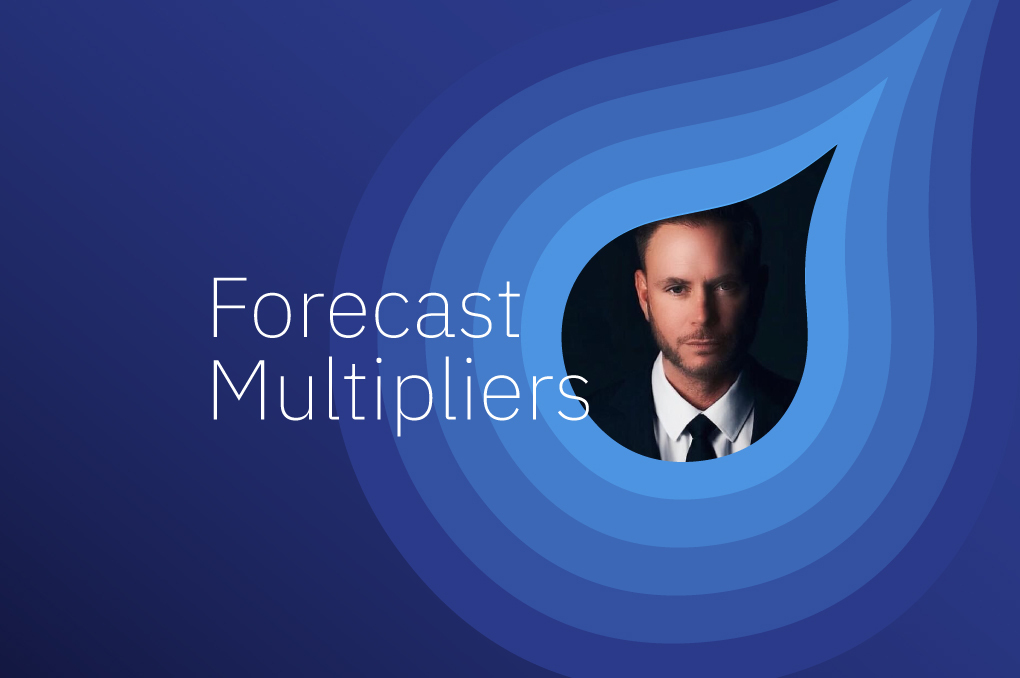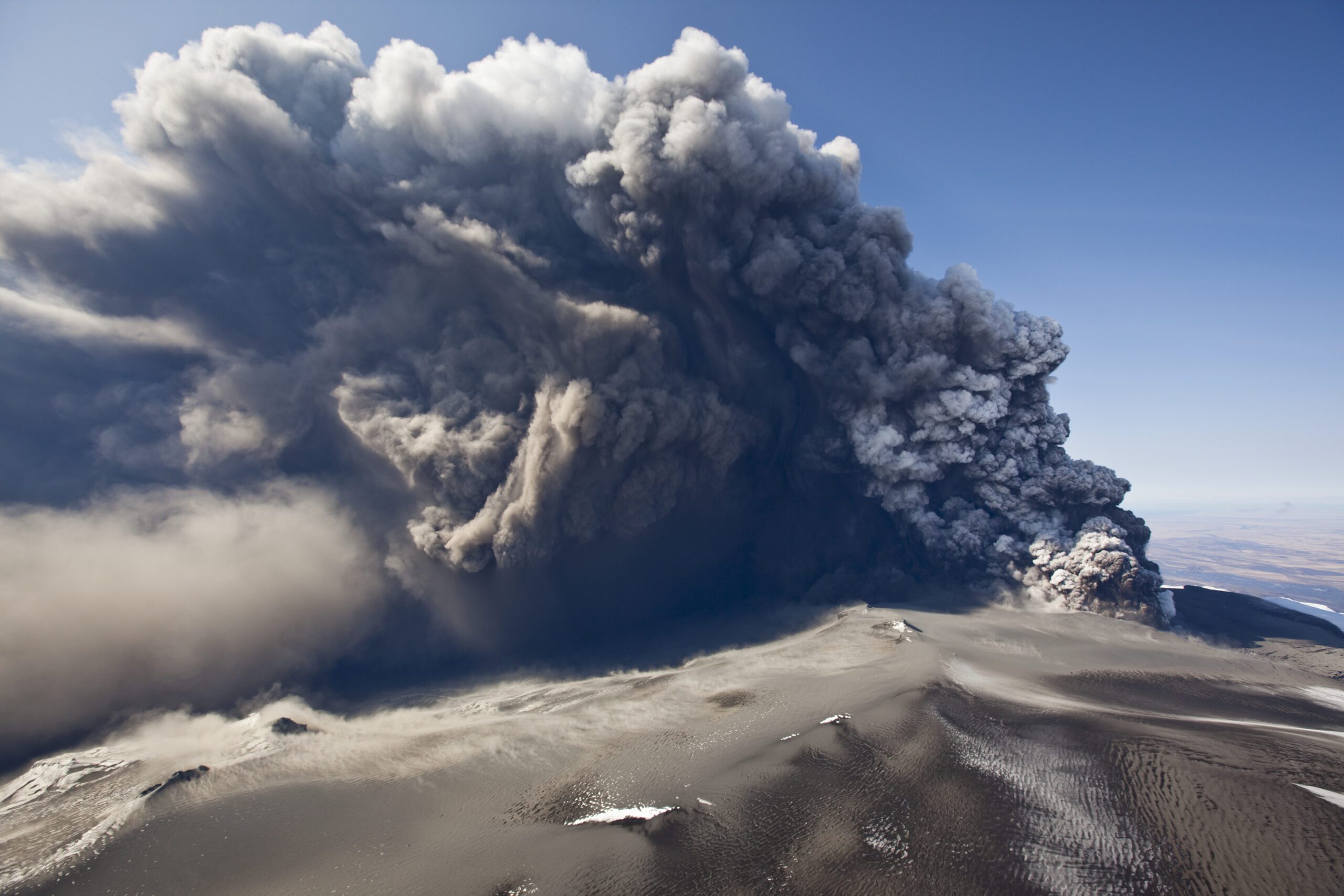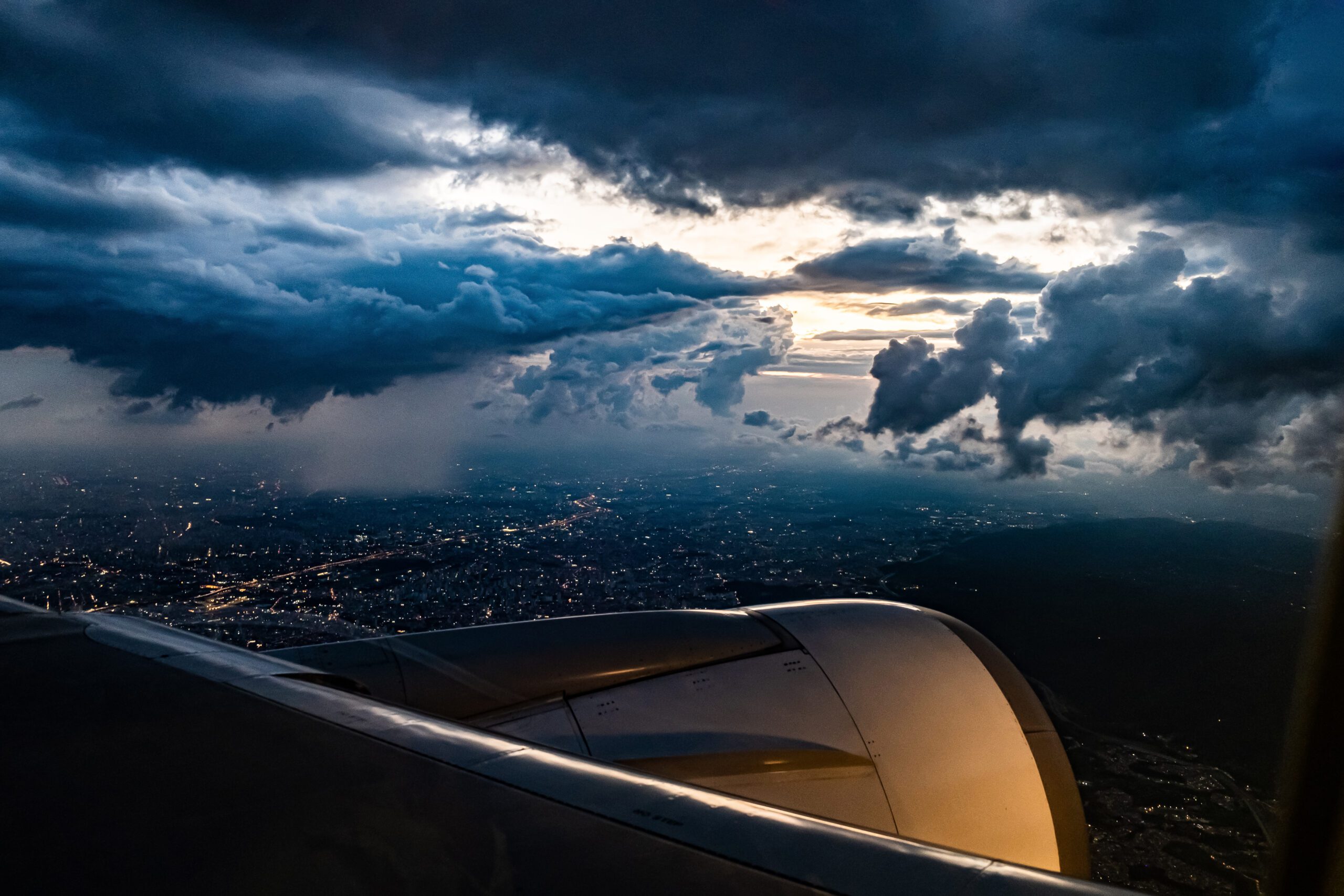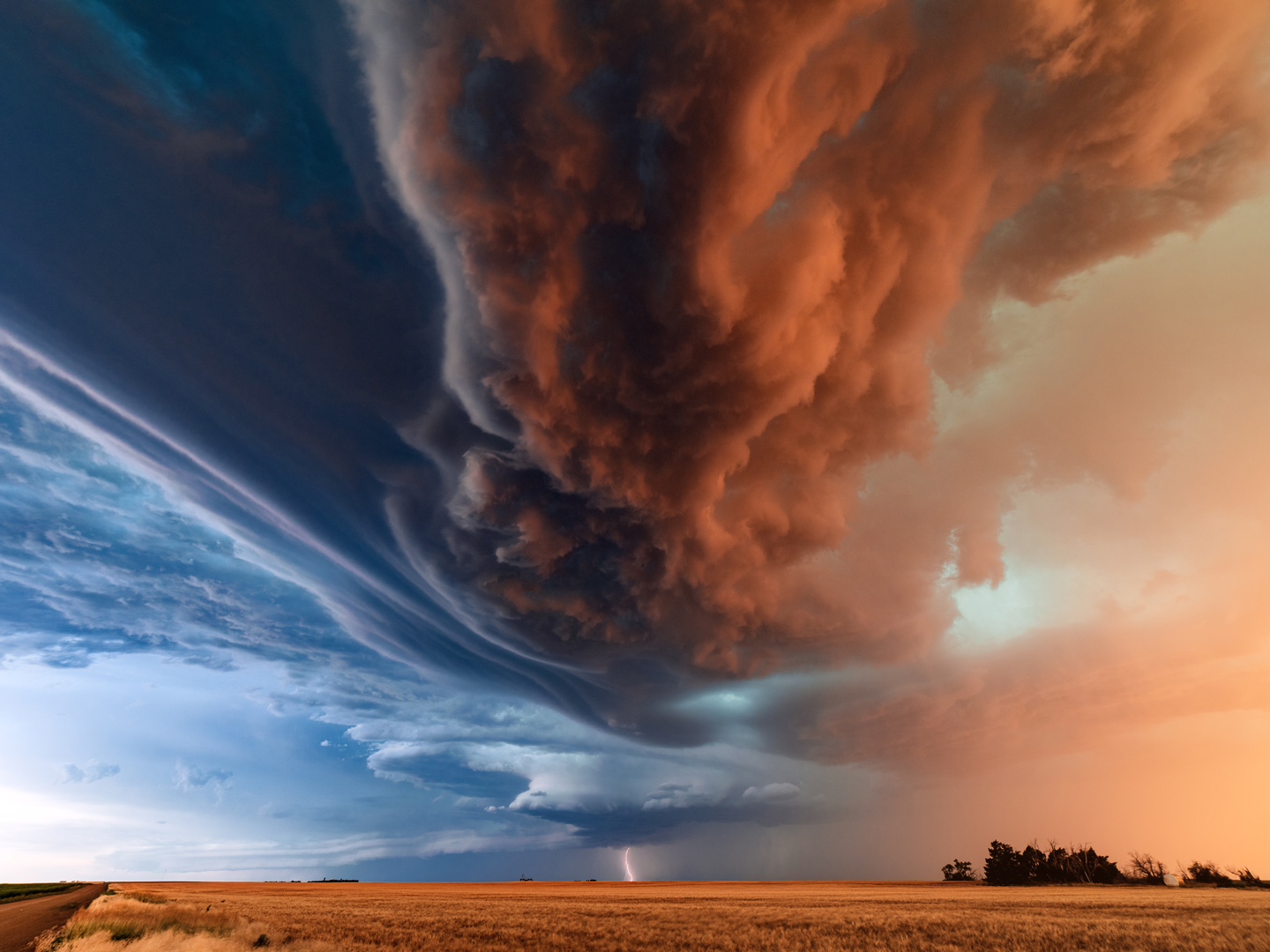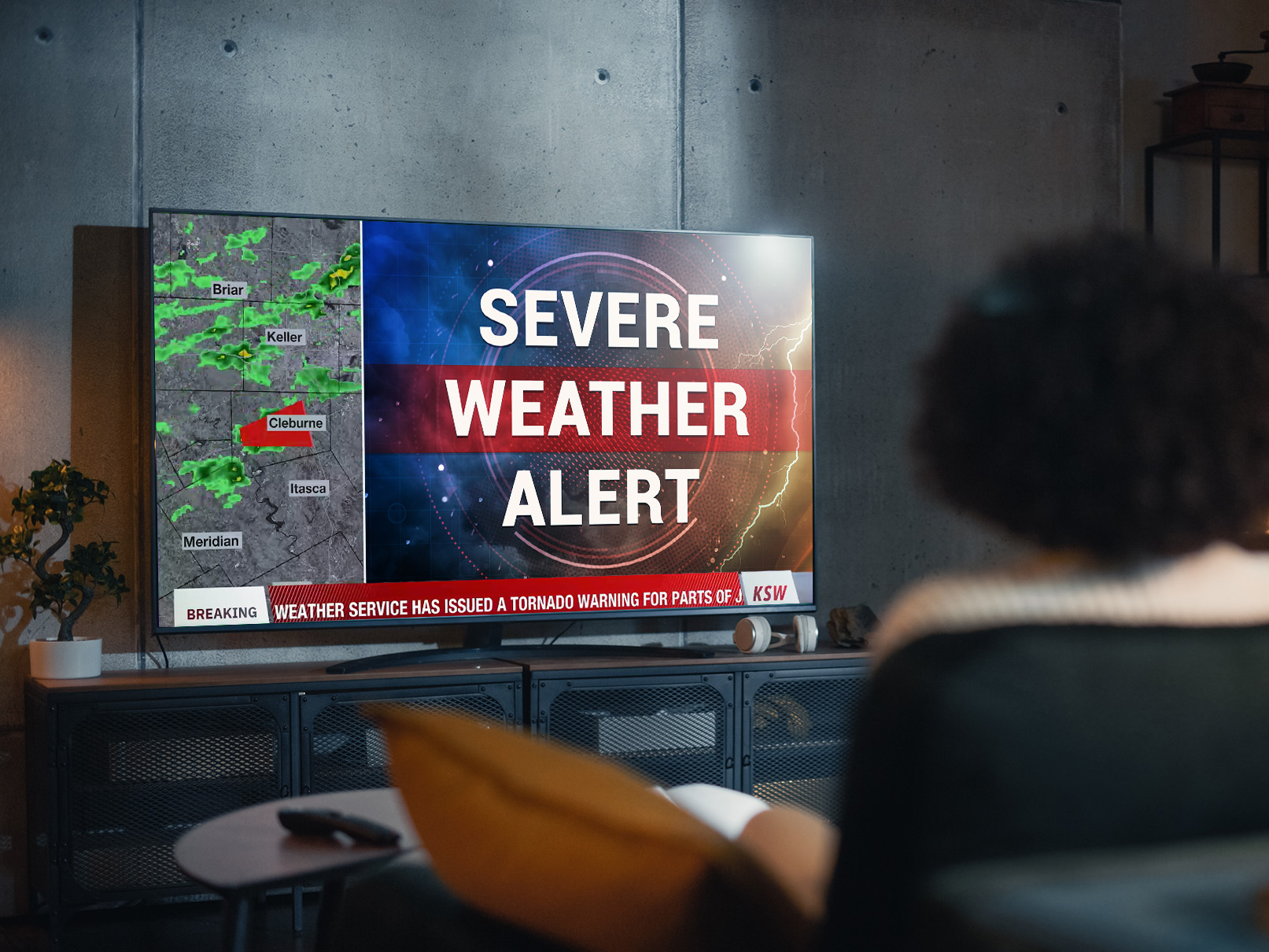Weather intelligence for the future: Crafting a strategic enterprise approach to changing environmental conditions
Continue readingEditor’s Note: Welcome to the first installment of The Weather Company’s Forecast Multipliers series, where top marketing leaders share career advice, a POV on hot topics in their category, and how to build a successful weather strategy.
When you think of e.l.f., what comes to mind? Perhaps it’s their accessible, often viral products for every eye, lip and face. Or, maybe you envy their relevance with Gen Z, fueled by witty social campaigns like the recent collaboration with buzzy brands and celebs like Liquid Death or Jennifer Coolidge (#dolphinskin).
However e.l.f. pops for you, one thing is clear: they’ve figured some things out in the marketing department. We sat down with Patrick O’Keefe, VP of Integrated Marketing Communications, for a candid conversation on his career and time at the cosmetics leader. Leading a dynamic team in paid, earned, and owned media, as well as immersive, experiential, and entertainment marketing, Patrick’s journey is filled with unexpected turns and rich experiences, offering valuable insights into the beauty industry and beyond.
From Mickey to military
Patrick’s professional journey began with a Disney internship, which profoundly influenced his career path. This whimsical start quickly shifted when he enlisted in the Air Force. From there, Patrick’s career took another turn when he joined association management firm, Smith Bucklin and Associates, which ultimately introduced him to the beauty industry. His next stops at Ketchum PR and major beauty brands like L’Oréal (14 years) and Shiseido (7 years) further honed his expertise, eventually leading him to e.l.f. We asked Patrick if he had any career advice. Here’s what he had to say:
Showing up and connecting deeper
Patrick emphasized that community is at the heart of e.l.f.’s marketing strategy. He explains, “We listen, we learn, and we lean in.” Clearly, it pays off: this approach has driven the success of numerous campaigns, including the launch of their Bronzing Drops and the Jelly Pop line. Hear more on what Patrick describes as “the center of our universe”:
By engaging with the community at every level, from TikTok Lives with the CEO to crowd-sourcing product feedback via creators, e.l.f. has fostered a deep connection with its audience. Patrick shared a few examples of bringing products to life with the help of their loyal community:
Taking big swings
Chances are, you’ve noticed e.l.f.’s uncanny knack for tapping into the cultural zeitgeist. The brand is known for its bold marketing strategies that start with an insight and scale through unexpected partnerships—like their recent Super Bowl commercial with Jennifer Coolidge that boosted e.l.f.’s Power Grip Primer to the top SKU in mass beauty. But it’s not just trial and error driving their approach; it’s taking calculated risks that stay true to the brand’s ethos of inclusivity and empowerment, every time. Patrick weighed in on the campaign:
Insights equal disruption
Another standout campaign from e.l.f. near and dear to our hearts: the hilarious “Glow Storm” campaign starring Meghan Trainor that leveraged weather as the insight that started it all. It resonated deeply with consumers, generating 5.7 billion PR impressions by leaning into humor and narrative-driven storytelling. Patrick shares how it came to life through an insights-driven marketing approach and how weather supercharged the campaign:
In fact, Patrick found the insights so powerful, they’ve changed his conversation with every agency on marketing efforts going forward:
Words of wisdom
Patrick is not only passionate about the work e.l.f. does, but also the values they stand for. “It all starts with a framework. We’re bold disruptors with a kind heart. We disrupt norms, we shape culture, and we connect communities… That’s the framework in which we operate everything we do, including people we hire. Whomever we work with has to be part of the spirit of the e.l.f. ethos,” he adds.
Patrick’s journey from Disney intern to marketing leader at e.l.f. underscores the importance of flexibility, lifelong learning, and the power of leaning into community-centric marketing. We can’t wait to see how e.l.f. continues to innovate, inspire, and connect with audiences. Patrick is eager to keep on showing us.
Let’s talk
What’s your weather strategy? To learn more about harnessing the power of weather to increase engagement and drive growth, contact our advertising experts today.
Contact usThis post is part two of a two-part blog series dedicated to severe thunderstorm education. Read the first installment.
Part one of this series explained why thunderstorms happen during springtime – and what specific weather phenomena creates them. Building on this, let’s go deeper into thunderstorms and convection in general. We’ll also share how The Weather Company’s solutions can help aviation industry professionals like you make better decisions that keep your customers and crews safe.
How does The Weather Company help aviation clients navigate thunderstorms?
Enroute hazards
The Weather Company’s Enroute Hazards solution forecasts organized clusters or lines of storms and produces convection hazards.
Single-cell thunderstorms can be strong to severe and cause significant damage. But they don’t usually meet the spatial distance, or coverage requirement, to warrant a convective hazard (like FPG or SIGMET) to be drawn in the area. For single-cell storms, where Enroute Hazards may not highlight the area with the drawn hazards, pilots can turn to onboard radar to avoid convection.
Onboard radar also helps with developing convection where updrafts can create severe turbulence.
Terminal aerodrome forecasts
The Weather Company issues Terminal Aerodrome Forecasts (TAFs) on a global scale.
With certain TAFs, mainly large hubs, The Weather Company may include a TAF discussion where the forecaster writes about potentially strong or severe storms and, in some cases, may also mention possible threats (i.e., hail, tornado, etc.) with that type of storm.
More about convective hazards
All of the convective hazards generated by The Weather Company include an average base and max height. No aircraft should try to fly below our convective hazards. That’s why we use an average base level.
Our Flight Plan Guidance (FPGs) are usually SCT-BKN (scattered to broken) in coverage which represents between 35% and 50% of coverage.
Typically, these are a strong line or an area of thunderstorms that have well-defined breaks, but not significant coverage.
The Weather Company team does have the ability to draw SCT FPGs from 15% to 35% in the vicinity of a select number of hubs in the United States and in more sensitive or highly traveled U.S. regions, including BOS-ORD-MEM-ORF-BOS.
When it comes to significant meteorological hazards (SIGMETs), they are either BKN, which is 50% to 75% coverage, or solid storms with greater than 75% coverage. BKN coverage is virtually an unbroken line, small breaks are likely, or an area of robust thunderstorms with significant coverage.
SIGMETing this coverage of thunderstorms is our way of advising aviation clients to avoid this area.
A solid area of storms is where there are no breaks in a line of thunderstorms or a large cluster of thunderstorms with no breaks in convection (i.e. Mesoscale Convective System).
Are thunderstorms the biggest risks for aviators?
The greatest threat to aircraft isn’t lightning–aircraft are built to withstand lightning strikes –but rather severe turbulence, hail, and icing.
The convective hazards produced by The Weather Company–like FPGs and SIGMETs–include implied turbulence and icing. It’s generally suggested that aircraft avoid these areas. Each airline will need to follow its individual standard operating procedure on how to handle this.
Hail damage to aircraft, including the windshield, or encountering severe turbulence, means that the aircraft will be taken out of service for maintenance. This impacts time, cost, and potentially airline credibility.
Let’s talk
To learn more about our advanced aviation weather solutions, contact our aviation experts today.
Contact usOne-size-fits-all weather content is no longer enough for today’s audiences.
As technology evolves and viewer preferences shift, the demand for highly localized, up-to-the-minute weather information is rapidly growing. Weather broadcasters need a new model to meet these preferences, one that isn’t bound by the constraints of traditional broadcast schedules.
This is where Connected TV (CTV) broadcasts become so essential.
What is CTV weather broadcasting and how does it work?
CTV weather broadcasting refers to the delivery of weather-related content through CTV devices such as Xbox, Roku, Apple TV and more. These devices connect to or are embedded in televisions to stream content over the internet.
In the context of weather broadcasting, CTV allows broadcasters to deliver real-time weather updates, forecasts, severe weather alerts, and other related content directly to viewers’ televisions via the internet. This approach leverages the interactivity and connectivity of digital media, allowing for more personalized and location-specific content. For instance, CTV viewers can access weather updates that are tailored to their exact location at any time, not just during scheduled broadcast times.
Through the integration of real-time data from satellites, radar, and weather stations, CTV systems process and tailor weather forecasts specific to each viewer’s location. This customization allows for a more personalized and engaging experience, enabling viewers to interact with the broadcast using their remote controls to explore in-depth weather maps and extended forecasts.
What is the difference between traditional and CTV weather broadcasts?
Traditional (or linear TV) weather broadcasts have been primarily broadcast Over the Air (OTA) or on cable, often at fixed times and with general content intended for broad audiences. In contrast, CTV weather broadcasts leverage the flexibility of online streaming platforms, offering viewers the ability to access weather updates at their convenience across a variety of platforms. This level of personalization makes CTV a better fit for today’s audiences, who expect access to real-time, relevant weather updates across a variety of devices.
What is the difference between OTT and CTV weather broadcasts?
While both Over-the-Top (OTT) and Connected TV (CTV) broadcasting are related, they are different. OTT encompasses the broader method of delivering streaming content. For example, viewers can watch live weather updates or emergency broadcasts directly on their mobile devices through apps like The Weather Channel app, which provides real-time alerts and forecasts wherever they are.
CTV, on the other hand, specifically refers to the internet-connected TV devices. The viewing experience mimics a traditional TV format but with modern connectivity features. Viewers can use these devices to stream dedicated weather channels that offer continuous live broadcasts and specialized content such as local weather reports tailored to their exact locations. CTV weather broadcasts are designed for these kinds of devices and are distributed via streaming channels.
An overview of CTV components
Viewers can access CTV weather broadcasts through a variety of devices and methods, including the following:
Smart TVs
Smart TVs’ integrated internet capabilities allow direct streaming of weather broadcasts, enabling viewers to access real-time weather information with just a few clicks on their remote controls.
Digital Media Players
Digital media players are devices that stream digital content to TVs, such as Chromecast, Amazon Fire Stick, and video game consoles. These devices allow users to switch seamlessly between watching their favorite shows and viewing the latest weather updates.
Set-Top Boxes
Cable boxes that provide internet connectivity and access to a plethora of streaming services also enable easy access to weather channels and apps.
Advantages of CTV weather broadcasting
The advanced streaming technology that powers CTV broadcasting has tremendous potential for improving your weathercasts. Here are just a few advantages that you can expect:
Cost-effective
CTV broadcasting has lower operational costs because of their simplified content distribution processes. It allows you to automate video creation and share content across multiple channels, reducing the need for extensive manual intervention.
Faster delivery
As broadcasting expands to include digital platforms and CTV alongside traditional linear TV, the need to quickly produce and distribute content has become critical. ReelSphere, a tool enhanced with AI, streamlines this process by automatically generating weather content. It allows you to create targeted, hyperlocal, and adaptive videos based on the forecast, day of the week and other factors. Being able to generate these videos across multiple channels helps ensure that your viewers receive weather information in a timely fashion.
Reaches a larger audience
CTV broadcasting effectively expands audience reach by leveraging advanced technologies to serve tailored weather videos across all digital platforms. For example, allowing on-air talent to incorporate viewer-submitted stories and social media posts into broadcasts. This approach allows you to tap into a broader demographic, including viewers who primarily consume content on mobile devices and online platforms.
Recent research supports this strategy, showing that 88% of respondents are at least somewhat interested in using local weather streaming services. By utilizing hyperlocal weather broadcasting tools, you can ensure that weather content is both accessible and relevant for local viewers.
Engagement
Weather broadcasting directly impacts people’s daily decisions, making it inherently engaging and important to viewers. For example, viewers stream CBS News Colorado’s digital weather content for an average of more than 30 minutes per day. This high level of engagement makes weather content a pivotal part of their streaming strategy, according to meteorologist Ashton Altieri.
Ability to scale hyperlocal content
With the right CTV weather content solution, you can effectively create targeted and hyperlocal videos at scale. This capability ensures that audiences in different regions receive weather updates that are tailored to their specific local conditions, meeting the growing demand for extremely targeted, relevant content. For example, showing the radar map only when there is precipitation in the forecast.
Though CTV solutions streamline workflows with weather forecast automation features, your team still retains the flexibility to manually edit and refine the content. This blend of automation and manual oversight ensures that you can maintain quality and accuracy even as your production of weather content scales up.
Advertising opportunities
CTV weather broadcasting opens up lucrative advertising opportunities that can significantly enhance revenue streams for your channel. Essentially, localized content provides an opportunity for extremely localized advertising that’s relevant to your viewers. In addition, according to the “Weather OTT Focus Groups & Quantitative Survey” conducted by Magid Research, 98% of advertisers would consider sponsoring weather content on CTV. With the increasing shift toward digital and connected media, weather streaming on CTV platforms presents a fresh and attractive avenue for monetization.
First-party data
Leveraging first-party data is a powerful strategy for CTV weather broadcasting, enabling your station to better target and deliver lifestyle videos that cater precisely to its viewers’ preferences and locations. By collecting and analyzing viewer data, such as viewing habits, preferred content types, and geographical information, you can tailor your weather broadcasts to enhance relevance and viewer engagement such as offering a golfer’s, beach or even runner’s forecast.
Create professional CTV weather broadcasts with ReelSphere
The Weather Company’s ReelSphere solution revolutionizes weather broadcasting by automating the production of on-demand, personalized weather content for CTV and OTT platforms. Leveraging the power of their Max platform and graphics, ReelSphere enables you to deliver curated content at the drop of a hat. The system automatically generates location-specific weather graphics and broadcast templates that vary depending on the time of the day and the existing weather conditions. By letting you scale up localized weather content quickly and efficiently, without expending additional resources, ReelSphere lets you harness the full benefits of the CTV streaming revolution.
People also asked questions
What weather software do meteorologists use?
Meteorologists use a range of sophisticated software tools designed to collect, analyze, and present weather data. These tools include models that predict weather patterns based on current atmospheric conditions gathered from satellites, radar, and ground-based sensors. They also use geographic information systems (GIS) to visually represent weather data on maps, which helps in analyzing and forecasting weather more effectively. Additionally, specialized software like Max helps meteorologists create visual representations of the weather for public broadcasts.
What weather data and model are most accurate?
Determining the most accurate weather data often depends on the region, forecast type, and specific weather events. No model is perfect. Public data from the National Weather Service (NWS) is renowned for its comprehensive and reliable forecasts, thanks to extensive data from satellites and radars. The Weather Company is the world’s most accurate weather forecaster overall, according to a 2017-2022 study from ForecastWatch: Global and Regional Weather Forecast Accuracy Overview, 2017-2022, commissioned by The Weather Company.
Let’s talk
To learn more about automated, digital weather content with ReelSphere, contact our media experts today.
Contact usIt takes a lot of effort for weather broadcasters to capture and keep their audience’s attention at a time when viewership is becoming increasingly fractured. It requires a mix of engaging graphics, accurate, up-to-date information, and high production quality to deliver broadcasts that resonate.
Striking the right balance is critical — after all, weather broadcasters play a pivotal role in bridging the gap between complex meteorological data and the public’s need for accessible and actionable weather information. To disseminate critical information quickly and in a compelling format, broadcasters need live broadcasting software that’s versatile enough to handle the many nuances of weather reporting.
Your live broadcasting software should empower your team of meteorologists and weather reporters to transform raw data into comprehensible and visually appealing broadcasts that can inform, educate, and sometimes even entertain viewers. Whether it’s tracking a storm in real-time, providing evacuation routes during a hurricane, or explaining the science behind a heatwave, the software that enables your broadcasts needs to ensure precision, speed, and clarity in every weather report.
What is live broadcasting software used for?
Live broadcasting software has become an essential tool in the meteorological and media fields, particularly for reporting severe weather events such as thunderstorms, wildfires, tornadoes, blizzards, and hurricanes. This technology enables real-time dissemination of crucial weather updates and information, leveraging advanced tools like satellites and weather radars to predict weather patterns. Your team can use these tools alongside forecasting models to issue alerts and provide the public with actionable information.
Of course, weather content is most relevant when it’s focused on a viewer’s local region. But delivering hyperlocal content at scale is difficult because it requires significant resources, both in terms of technology and human expertise.
Live broadcasting software minimizes these challenges. It has been instrumental in powering 24/7 weather streaming services with hyperlocal content for communities across the globe. As audiences — especially younger generations — begin to favor streaming services, this technology enables you to reach viewers directly on their preferred platforms.
What are the advantages of broadcasting weather live?
Live weather broadcasts have been a local news staple for decades. But what’s groundbreaking is the ability to stream real-time updates 24/7 from anywhere. Viewers can gain access to valuable weather information right when they need it — without having to wait until the 6 o’clock news rolls around.
Timely
No matter where viewers live or what devices they use, live broadcasting software enables you to reach them with immediate weather updates for their local area. This is especially critical when weather conditions change rapidly because the accuracy of the information can significantly impact viewers’ decisions and safety. Live broadcasting software empowers your team to support real-time updates across streaming channels for every locality you serve without scaling staff or resources.
Highly engaging
Live weather broadcasts have the power to captivate audiences. Ashton Altieri from CBS Colorado noted that platforms like over-the-top (OTT) streaming channels have seen increased viewer engagement, with audiences dedicating a significant amount of time to consuming weather content. This engagement is critical for maintaining and growing your viewer base at a time when fewer households consume weather reports through traditional news broadcasts.
Loyalty
According to research commissioned by Magid and The Weather Company, only 44% of viewers use cable or satellite as a primary source for weather updates on TV. This means that there’s a tremendous opportunity to drive audience engagement by offering more relevant and personalized live weather broadcasts — especially for streamers. More than a third (40%) of all TV viewership is now streaming-related. By offering live streaming options, your company can capture more of this audience share.
Reusable
A robust weather broadcast software lets you repurpose content from live broadcasts across multiple channels, maximizing reach and engagement. This versatility allows you to leverage social media platforms, websites, and mobile apps to make your broadcast content accessible to audiences, wherever they are.
Revenue opportunities
Expanding beyond linear broadcasting into live connected television (CTV) presents a lucrative opportunity for boosting your company’s revenue potential. Magid predicts the CTV revenue stream will grow from $2.7 billion to $3.5 billion by 2027. Additionally, 98% of broadcasters are interested in sponsoring weather content on CTV and OTT platforms.
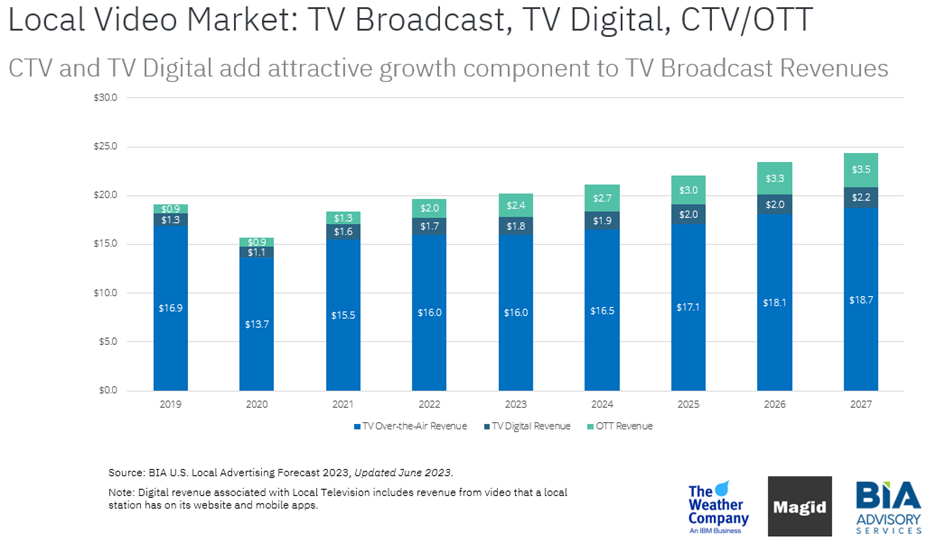

The advantage of CTV and OTT advertising lies in their capacity for hyperlocal targeting, offering advertisers unprecedented precision in reaching specific markets and tailoring campaigns to local audiences. This is especially attractive for advertisers that have historically invested in ad placements on local TV stations, including legal service providers, hospital networks, and car dealerships.
Where can a live weather broadcast software be used?
Live weather broadcast software can enhance all aspects of weather programming, from the newsroom to the field. Here are just a few ways live weather broadcast software can be used to deliver more high-quality reports.
Newsroom broadcasts
Live broadcasting software is vital in newsrooms for swiftly creating and sharing weather reports and alerts, keeping viewers well-informed when they need it most. During a broadcast, every second matters, which makes having a seamless, responsive software infrastructure essential.
Reporting on-location
Remote broadcasts transmit video and audio content from remote locations back to your studio using digital video transmission, cloud-based platforms, and remote control systems. This setup gives your team of meteorologists greater flexibility in how they cover specific weather conditions. On-location reporting lends immediacy to weather updates. It offers viewers firsthand insights into weather conditions, making the information more relevant and engaging. This approach also adds a human touch to weather reporting that is difficult to replicate. When paired with tools like augmented reality, reporting outdoors or outside of the typical studio can immerse an audience into a whole new world of storytelling.
6 key considerations for a live weather broadcast software
Not all live broadcast software is created equal. The right software for your organization will depend on your specific needs and preferences. Ask yourself what features are non-negotiable, and begin your search from there.
1. Streamlined workflow
Software with streamlined weather broadcast workflow capabilities can help you create and distribute weather content from any location, at any time. This flexibility allows for seamless collaboration among remote and hybrid team members, eliminating production delays that prevent you from delivering real-time weather updates across channels.
2. Simple to manage
The ideal live broadcast solution should enable your team to create and distribute weather content without needing extensive technical skills or advanced hardware. These features include user-friendly interfaces, preset broadcast templates for quick content creation, and automatic updates to ensure the software remains current without manual intervention.
3. Cloud storage
Prioritize the integration of cloud storage in your broadcasting software selection. This essential feature helps ensure that live streams and generated content are securely backed up and easily accessible for future use across various mediums.
4. Asset library
Access to a well-organized asset library containing pre-developed weather graphics, templates, and other resources aligned with brand guidelines supports the production of professional and consistent live streams. This repository is invaluable for maintaining brand identity and enhancing the visual appeal of weather broadcasts, especially when you’re moving fast to publish real-time severe weather alerts and warnings.
5. Accuracy & speed
Weather consumers want faster access to information and more up-to-date reports on severe weather, according to a report commissioned by Magid and The Weather Company. Live broadcast software can help you automate content delivery with minimal manual oversight.
The most robust solutions employ sophisticated models, analysis tools, and data feeds that enable your team to improve predictions and deliver accurate forecasts. For example, The Weather Company integrates with the National Weather Service (NWS) to ensure broadcasts always utilize up-to-date weather data from an authoritative source. The Weather Company’s Max Alert Live solution actually has a direct integration with the NWS so alerts are automatically surfaced in order to be the first to air with live-saving information.
6. Production quality
Poorly produced weather segments distract viewers, leading them to tune out your broadcasts. High-quality video production can keep audiences engaged — and you don’t need big teams of professional videographers and animators to pull it off. As a bonus, you can unlock more advertising opportunities, especially in hyperlocal markets, as your volume of published content increases without risking quality.
Broadcast software that’s easy for teams to use with minimal training can take your production quality to the next level. In particular, features like augmented reality can significantly enhance the viewer experience, making complex weather information more understandable and visually appealing. Viewers often tune out standard weather graphic illustrations, but augmented reality can make weather reports more cinematic and engaging. Ultimately, the technology opens up new avenues for creativity in weather storytelling.
Share your broadcast live streams from anywhere at any time with Max Velocity
The Weather Company’s Max Velocity solution is at the cutting edge of broadcast software, enabling broadcasters to produce and share compelling weather content on various digital platforms from anywhere at any time efficiently.
By automating content creation and leveraging advanced broadcast software, Max Velocity allows for personalized, hyperlocal weather reports and alerts. This not only increases engagement across digital platforms but also provides your team of meteorologists with the tools to deliver impactful weather stories.
Interested in hearing more about how Max Velocity and other advanced broadcasting software can take your weather reports to the next level? Get in touch today to get the conversation started.
Let’s talk
To learn more about choosing the right live weather broadcasting software, contact our media experts today.
Contact us
